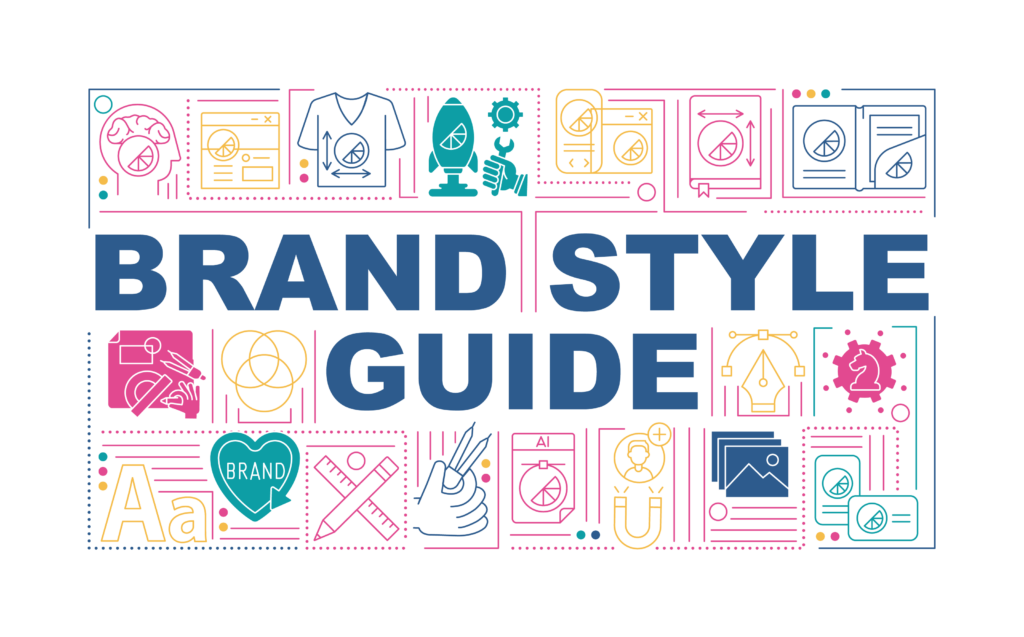Brand manual, brand guidelines, or brand book? However you refer to it, this important document is essential for reinforcing your brand’s identity and communicating with consistency. It’s not there to limit your creativity, but to act as a guide – think of it as a critical friend, someone (or something) you can turn to when you need clarity. In this blog, I’ll answer the questions, what is a brand manual, and why is it so important?
What is a brand manual?
A brand manual is the complete ‘how to’ guidebook for your brand. Anyone reading your brand guidelines should be able to apply your brand successfully in any given situation.
Let’s say, for example, that you’ve asked a signage company to design some new window decals for your shop. Your brand manual should have a section on signage, that outlines which version of the logo to use, how to apply it, and what else to include.
But it’s not just written for people outside of your business. An up-to-date brand manual is also a useful reference for employees, and for initiating new starters into your company.
Why is a brand manual important?
Having one manual that everyone can refer to is a great way of keeping your whole team on the same page. A clear set of guidelines leaves no room for interpretation, which reduces the likelihood of you stumbling upon any variations of your brand identity.
Building and maintaining a recognisable, strong identity relies on consistency. Your customers (and the people thinking of buying from you) may recognise who you are now, but any change to your identity could throw everything into question.
If Adidas suddenly lost a stripe, their customers would be the first to notice! It may seem like a small thing, but their proposition is built on the familiar three stripe logo.
Without consistency, you risk confusing your customers and losing sales.
What should your guidelines contain?
What you include in your brand guidelines depends on the type and size of your business. For some, a basic manual that covers a brand’s visual identity is enough.
As a minimum, it should include:
- logo
- colours
- typography
Logo
This section of your brand manual should set out the rules for using your logo – how to use it correctly, and importantly how not to use it! Start by setting the ground rules for your main, full colour logo, then move on to cover its variations, such as:
- the ‘reversed out’ version (usually white)
- one colour and two colour versions for print
- responsive logos for desktop, tablet, and mobile
- when to use it with and without its strapline
- different layouts, eg, landscape, portrait, square
The more detail you can provide, the easier it will be for agencies to apply it correctly.
Colours
Most brands have a palette of colours that forms part of their visual identity. Making sure they are used consistently is just as important as governing the logo itself.
Colours render differently on screen and in print, so it’s up to the brand book to set out the right colour references for each application. Every colour in your palette should be covered in your manual – as a minimum you should include:
- a CMYK reference for full colour print
- an RGB (or HEX) code for use on-screen
This ensures everyone involved in making creative decisions is using the same colours.
Typography
This section of the manual should contain everything relating to the typography across your brand. Start by detailing the fonts in your logo, then move on to:
- headlines
- sub-headers
- body copy
If you always write headlines in capital letters, or your sub-headers are always in green, the it will include all this information. The more detail, the better.
Who should write your guidelines, and when?
We’ve answered the big questions – what is a brand manual, and why is it so important?
But just as critical is who should write your guidelines and when? Typically, your brand guidelines are created when you first establish an identity or re-brand, and they are written by the creative agency responsible for the branding work.
It’s important that your brand book doesn’t just sit on a shelf gathering dust and that you regularly update it. The marketing landscape is changing all the time, and as you add new channels or media to your armoury, you should also add them to your manual.
Evolving your brand guidelines
To keep your brand manual up-to-date, I recommend asking these questions:
1. Evaluate
What do your guidelines currently include and are there any gaps?
2. Identify
Where does your audience ‘hang out’, are you missing any opportunities?
3. Adapt
What do these new channels require – tone of voice, imagery, assets?
4. Distribute
Who needs access to your brand manual and how will you distribute it?
Keeping your brand guidelines up-to-date has never been more important. It’s estimated that there is a 20% increase in digital touchpoints every year, and each channel requires a different approach that must be documented.
Choosing the right tone of voice for each channel is crucial – and they won’t all be the same. You could cover this in a separate communication manual, or simply expand your brand guidelines to include things like messaging and brand values.
So, what is a brand manual?
Now that we know a bit more, we can refine our definition of a brand manual.
This important guidebook is a ‘how to’ for anyone using your visual identity, but it’s also a living document that should regularly be updated. It represents an opportunity to uncover new tactics, and assess how you might use them.
So, what is a brand manual? It’s a rare chance to reflect, and as business owners we don’t get many of those. If you’re looking for someone to help you step back and evaluate your brand, then let’s get together and have a brew! I offer 1:1 coaching and consultancy to help busy people move their business forward – book a brew by phone or Zoom to get started.

